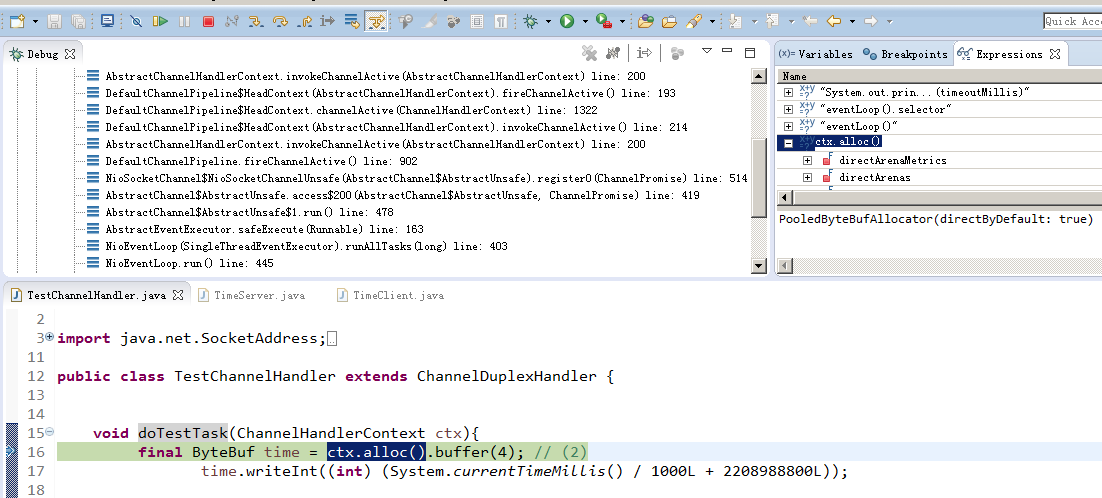

每种ByteBuf都有相应的分配器ByteBufAllocator,类似工厂模式。我们先学习UnpooledHeapByteBuf与其对应的分配器UnpooledByteBufAllocator
如何知道alloc分配器那是个?
可以从官方下载的TimeServer 例子来学习,本项目已有源码可在 TestChannelHandler.class里断点追踪
从图可以看出netty 4.1.8默认的ByteBufAllocator是PooledByteBufAllocator,可以参过启动参数-Dio.netty.allocator.type unpooled/pooled 设置
细心的读者可以看出分配ByteBuf只有pool跟unpool,但ByteBuf有很多类型,可能出于使用方面考虑,有时不一定设计太死板,太规范反而使学习成本很大

public final class ByteBufUtil { static final ByteBufAllocator DEFAULT_ALLOCATOR; static { String allocType = SystemPropertyUtil.get( "io.netty.allocator.type", PlatformDependent.isAndroid() ? "unpooled" : "pooled"); allocType = allocType.toLowerCase(Locale.US).trim(); ByteBufAllocator alloc; if ("unpooled".equals(allocType)) { alloc = UnpooledByteBufAllocator.DEFAULT; } else if ("pooled".equals(allocType)) { alloc = PooledByteBufAllocator.DEFAULT; } else { alloc = PooledByteBufAllocator.DEFAULT; } DEFAULT_ALLOCATOR = alloc; } }
AbstractReferenceCountedByteBuf是统计引用总数处理,用到Atomic*技术。
refCnt是从1开始,每引用一次加1,释放引用减1,当refCnt变成1时执行deallocate由子类实现
public abstract class AbstractReferenceCountedByteBuf extends AbstractByteBuf { private static final AtomicIntegerFieldUpdater<AbstractReferenceCountedByteBuf> refCntUpdater = AtomicIntegerFieldUpdater.newUpdater(AbstractReferenceCountedByteBuf.class, "refCnt"); private volatile int refCnt = 1; @Override public ByteBuf retain() { return retain0(1); } private ByteBuf retain0(int increment) { for (;;) { int refCnt = this.refCnt; final int nextCnt = refCnt + increment; if (nextCnt <= increment) { throw new IllegalReferenceCountException(refCnt, increment); } if (refCntUpdater.compareAndSet(this, refCnt, nextCnt)) { break; } } return this; } @Override public boolean release() { return release0(1); } private boolean release0(int decrement) { for (;;) { int refCnt = this.refCnt; if (refCnt < decrement) { throw new IllegalReferenceCountException(refCnt, -decrement); } if (refCntUpdater.compareAndSet(this, refCnt, refCnt - decrement)) { if (refCnt == decrement) { deallocate(); return true; } return false; } } } protected abstract void deallocate(); }
对于ByteBuf I/O 操作经常用的是 writeByte readByte两种
由于ByteBuf支持多种bytes对象,如 OutputStream、GatheringByteChannel、ByteBuffer、ByteBuf等,
我们只拿两三种常用的API来做分析,其它逻辑大同小异
如果读者有印象的话,通常底层只负责流程控制,实现交给应用层/子类处理,AbstractByteBuf.class writeByte/readByte 也是这种处理方式
public class UnpooledHeapByteBuf extends AbstractReferenceCountedByteBuf { //分配器 private final ByteBufAllocator alloc; //数据 byte[] array; //临时ByteBuffer,用于内部缓存 private ByteBuffer tmpNioBuf; private UnpooledHeapByteBuf( ByteBufAllocator alloc, byte[] initialArray, int readerIndex, int writerIndex, int maxCapacity) { //省去部分代码同边界处理 super(maxCapacity); this.alloc = alloc; array = initialArray; this.readerIndex = readerIndex; this.writerIndex = writerIndex; } //获取ByteBuffer容量 @Override public int capacity() { ensureAccessible(); return array.length; } @Override public boolean hasArray() { return true; } //获取原始数据 @Override public byte[] array() { ensureAccessible(); return array; } //扩容/缩容 @Override public ByteBuf capacity(int newCapacity) { ensureAccessible(); //newCapacity参数边界判断 if (newCapacity < 0 || newCapacity > maxCapacity()) { throw new IllegalArgumentException("newCapacity: " + newCapacity); } int oldCapacity = array.length; //扩容处理,直接cp到新的array if (newCapacity > oldCapacity) { byte[] newArray = new byte[newCapacity]; System.arraycopy(array, 0, newArray, 0, array.length); setArray(newArray); } else if (newCapacity < oldCapacity) { //减容处理 //这里有两种处理情况 //1.readerIndex > newCapacity 说明还有数据未处理直接将 readerIndex,writerIndex相等 newCapacity //2.否则 writerIndex =Math.min(writerIndex,newCapacity),取最少值,然后直接复制数据 //可以看出netty处理超出readerIndex、writerIndex 限界直接丢弃数据。。。。。。 byte[] newArray = new byte[newCapacity]; int readerIndex = readerIndex(); if (readerIndex < newCapacity) { int writerIndex = writerIndex(); if (writerIndex > newCapacity) { writerIndex = newCapacity this.writerIndex = writerIndex; } System.arraycopy(array, readerIndex, newArray, readerIndex, writerIndex - readerIndex); //System.arraycopy(复制来源数组, 来源组起始坐标, 目标数组, 目标数组起始坐标, 复制数据长度); } else { this.readerIndex = newCapacity; this.writerIndex = newCapacity; } setArray(newArray); } return this; } }
AbstractByteBuf.class readBytes 调用子类实现 getBytes方法,区别是调用readBytes会改变readerIndex记录
public abstract class AbstractByteBuf extends ByteBuf { @Override public ByteBuf readBytes(ByteBuffer dst) { int length = dst.remaining(); //checkReadableBytes(length); if (readerIndex > (writerIndex - length)) { throw new IndexOutOfBoundsException(String.format( "readerIndex(%d) + length(%d) exceeds writerIndex(%d): %s", readerIndex, length, writerIndex, this)); } //调用子类实现 getBytes(readerIndex, dst); //记录已读长度 readerIndex += length; return this; } @Override public ByteBuf readBytes(ByteBuf dst, int dstIndex, int length) { checkReadableBytes(length); getBytes(readerIndex, dst, dstIndex, length); readerIndex += length; return this; } //这里如果index不为负的话只需要 capacity - (index + length) < 0 判断就可以 //用到 | 运算 如果 index为-1的话 index | length 还是负数 第二个 | (index + length)运算有可能 index + length相加为负 public static boolean isOutOfBounds(int index, int length, int capacity) { return (index | length | (index + length) | (capacity - (index + length))) < 0; } }
public class UnpooledHeapByteBuf extends AbstractReferenceCountedByteBuf { //支持ByteBuffer读取 @Override public ByteBuf getBytes(int index, ByteBuffer dst) { //checkIndex(index, dst.remaining()); if (isOutOfBounds(index, dst.remaining(), capacity())) { throw new IndexOutOfBoundsException(String.format( "index: %d, length: %d (expected: range(0, %d))", index, dst.remaining(), capacity())); } dst.put(array, index, dst.remaining()); return this; } //支持ByteBuf读取 @Override public ByteBuf getBytes(int index, ByteBuf dst, int dstIndex, int length) { checkDstIndex(index, length, dstIndex, dst.capacity()); //是unsafe类型,要调用jdk unsafe方法复制 if (dst.hasMemoryAddress()) { PlatformDependent.copyMemory(array, index, dst.memoryAddress() + dstIndex, length); } else if (dst.hasArray()) { //如果是数组即 heap类型,直接复制过去 getBytes(index, dst.array(), dst.arrayOffset() + dstIndex, length); } else { dst.setBytes(dstIndex, array, index, length); } return this; } //支持数组读取 @Override public ByteBuf getBytes(int index, byte[] dst, int dstIndex, int length) { checkDstIndex(index, length, dstIndex, dst.length); System.arraycopy(array, index, dst, dstIndex, length); return this; } }
AbstractByteBuf.class writeBytes 调用子类实现 setBytes方法,区别是调用writeBytes会改变writerIndex记录
public abstract class AbstractByteBuf extends ByteBuf { @Override public ByteBuf writeBytes(ByteBuf src) { writeBytes(src, src.readableBytes()); return this; } @Override public ByteBuf writeBytes(ByteBuf src, int length) { if (length > src.readableBytes()) { throw new IndexOutOfBoundsException(String.format( "length(%d) exceeds src.readableBytes(%d) where src is: %s", length, src.readableBytes(), src)); } writeBytes(src, src.readerIndex(), length); //读取src数据到this.ByteBuf 所以要更改src readerIndex src.readerIndex(src.readerIndex() + length); return this; } @Override public ByteBuf writeBytes(ByteBuf src, int srcIndex, int length) { ensureAccessible(); //是否扩容处理 ensureWritable(length); //调用子类实现 setBytes(writerIndex, src, srcIndex, length); //记录已写长度 writerIndex += length; return this; } private void ensureWritable0(int minWritableBytes) { if (minWritableBytes <= writableBytes()) { return; } //写入数据长度大于最大空间剩余长度抛异常 if (minWritableBytes > maxCapacity - writerIndex) { throw new IndexOutOfBoundsException(String.format( "writerIndex(%d) + minWritableBytes(%d) exceeds maxCapacity(%d): %s", writerIndex, minWritableBytes, maxCapacity, this)); } //通过分配器计算,参数1写完后的writerIndex记录,参数2最大容量长度 int newCapacity = alloc().calculateNewCapacity(writerIndex + minWritableBytes, maxCapacity); //子类实现 capacity(newCapacity); } //////////////////////////////AbstractByteBufAllocator.class////////////////////////////////////// @Override public int calculateNewCapacity(int minNewCapacity, int maxCapacity) { if (minNewCapacity < 0) { throw new IllegalArgumentException("minNewCapacity: " + minNewCapacity + " (expectd: 0+)"); } if (minNewCapacity > maxCapacity) { throw new IllegalArgumentException(String.format( "minNewCapacity: %d (expected: not greater than maxCapacity(%d)", minNewCapacity, maxCapacity)); } final int threshold = 1048576 * 4; // 4 MiB page if (minNewCapacity == threshold) { return threshold; } //如果新容量大于4M,不走双倍扩大算法,数值范围取 minNewCapacity <= maxCapacity if (minNewCapacity > threshold) { // 除以threshold再乘以threshold得出的结果是 threshold的倍数,可以理解是去掉余数 int newCapacity = minNewCapacity / threshold * threshold; //如果剩余容量不够4M直接给maxCapacity,否则自增4M if (newCapacity > maxCapacity - threshold) { newCapacity = maxCapacity; } else { newCapacity += threshold; } return newCapacity; } //newCapacity <<= 1 意思是 newCapacity*2,双倍自增 int newCapacity = 64; while (newCapacity < minNewCapacity) { newCapacity <<= 1; } return Math.min(newCapacity, maxCapacity); } }
//setBytes逻辑跟getBytes一样 public class UnpooledHeapByteBuf extends AbstractReferenceCountedByteBuf { @Override public ByteBuf setBytes(int index, ByteBuf src, int srcIndex, int length) { checkSrcIndex(index, length, srcIndex, src.capacity()); if (src.hasMemoryAddress()) { PlatformDependent.copyMemory(src.memoryAddress() + srcIndex, array, index, length); } else if (src.hasArray()) { setBytes(index, src.array(), src.arrayOffset() + srcIndex, length); } else { src.getBytes(srcIndex, array, index, length); } return this; } @Override public ByteBuf setBytes(int index, byte[] src, int srcIndex, int length) { checkSrcIndex(index, length, srcIndex, src.length); System.arraycopy(src, srcIndex, array, index, length); return this; } }
总结:
1.writeBytes跟setBytes、readBytes跟getBytes区别是前者有记录,后者没有,而后者是子类的实现
2.扩容算法是两种策略:
2.1.大于4M时不走double自增,数值范围取 minNewCapacity <= maxCapacity
2.2.少于4M时从64开始double自增
3.更改容量也是每个子类实现,要考虑两种情况
3.1.大于当前容量
3.2.小于当前容量,当小于的时候要考虑 readerIndex、writerIndex边界,当超过 readerIndex、writerIndex边界heap的策略是丢去原来的数据
4.heap是继承 AbstractReferenceCountedByteBuf的,当refCnt记录为1时释放数据